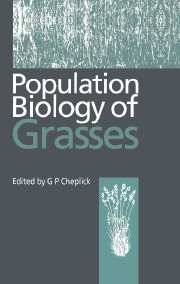Book contents
- Frontmatter
- Contents
- Contributors
- Preface
- Darwin revisited: approaches to the ecological study of grasses
- Part one Population variation and life history patterns
- Part two Ecological interactions
- 8 Plant–plant interactions in grasses and grasslands
- 9 Competition between grasses and woody plants
- 10 Fungal endophyte infection and the population dynamics of grasses
- 11 Arbuscular mycorrhizas and the population biology of grasses
- Part three Population biology of specific groups
- Index
10 - Fungal endophyte infection and the population dynamics of grasses
Published online by Cambridge University Press: 14 September 2009
- Frontmatter
- Contents
- Contributors
- Preface
- Darwin revisited: approaches to the ecological study of grasses
- Part one Population variation and life history patterns
- Part two Ecological interactions
- 8 Plant–plant interactions in grasses and grasslands
- 9 Competition between grasses and woody plants
- 10 Fungal endophyte infection and the population dynamics of grasses
- 11 Arbuscular mycorrhizas and the population biology of grasses
- Part three Population biology of specific groups
- Index
Summary
Introduction
Grasses have many interesting features of their population biology that are explored in detail in this volume. One of the most unique features of grasses is their symbiotic association with systemic fungal endophytes (Clavicipitaceae, Ascomycota) that grow within or on aboveground plant parts. These fungi can have significant effects on all aspects of the grass life cycle from germination and establishment to growth and reproduction. The population biology of grasses therefore varies with their endophyte infection status.
Plant population biology research has focused on describing patterns of recruitment, survival and reproduction, and on investigating how resource levels, density and genetic variability affect these processes. Increasing attention is being given to microbial symbioses in plant population dynamics (Burdon, 1987; Allen, 1991; Jarosz & Davelos, 1995). Mycorrhizal fungi infecting grasses enhance nutrient uptake and plant vigour, and alter interactions with pathogens and competitors (Hartnett et al., 1993; Stanley, Koide & Shumway, 1993; Newsham, Fitter & Watkinson, 1995; Newsham & Watkinson, this volume). Other mutualistic microbes in the rhizosphere and phyllosphere of grasses also occur (Turkington et al., 1988; Bever, 1994). For example, a nitrogen-fixing bacterial endophyte in the stems of sugar cane contributes most or all of the plant's nitrogen requirements (Dong et al., 1994). Fungal pathogens have been better studied compared with mutualists, especially in agricultural systems where grasses predominate (Burdon, 1987; Dinoor & Eshed, 1984; Clay, 1995). In contrast with mutualists, pathogens reduce the survival, growth and reproduction of host grasses (Mack & Pyke, 1984; Clay, Cheplick & Marks, 1989; Van der Putten, Van Dijk & Peters, 1993; Fowler & Clay, 1995; Govinthasamy & Cavers, 1995).
- Type
- Chapter
- Information
- Population Biology of Grasses , pp. 255 - 285Publisher: Cambridge University PressPrint publication year: 1998
- 38
- Cited by



